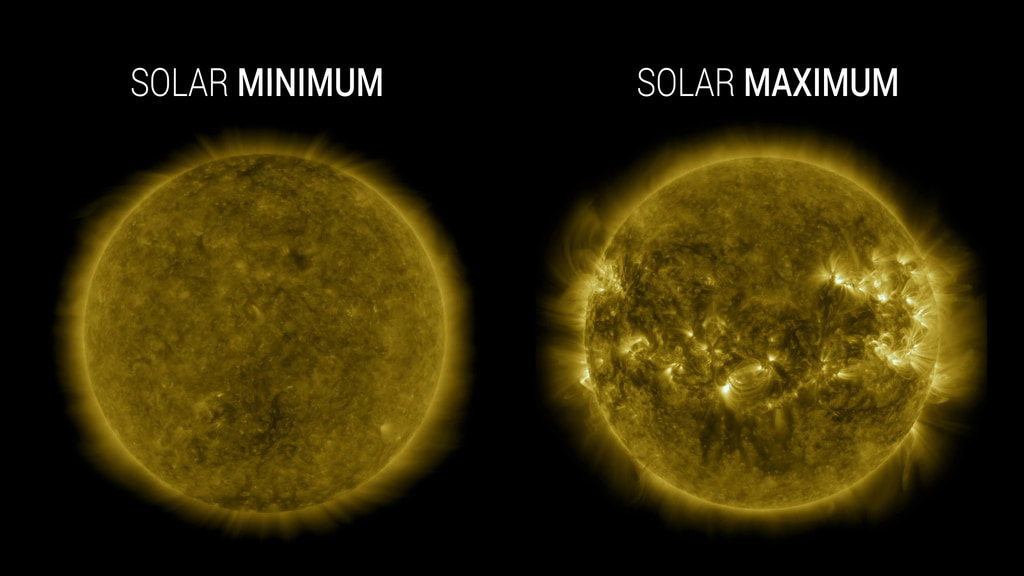How To Track The Solar Cycle
A new solar cycle comes roughly every 11 years. Over the course of each cycle, the Sun transitions from relatively calm to active and stormy, and then quiet again; at its peak, the Sun’s magnetic poles flip. Now that the star has passed solar minimum, scientists expect the Sun will grow increasingly active in the months and years to come.
Understanding the Sun’s behavior is an important part of life in our solar system. The Sun’s outbursts—including eruptions known as solar flares and coronal mass ejections—can disturb the satellites and communications signals traveling around Earth, or one day, Artemis astronauts exploring distant worlds. Scientists study the solar cycle so we can better predict solar activity. As of 2020, the Sun has begun to shake off the sleep of minimum, which occurred in December 2019, and Solar Cycle 25 is underway. Scientists use several indicators to track solar cycle progress.
Watch this video on the NASA Goddard YouTube channel.
Complete transcript available.
Music credits: “Infinite” by Joseph Pincus [ASCAP]; “Reflective Sensations”, “Ideas For Tomorrow”, “Think Tank” by Laurent Dury [SACEM]; “Wonderful Orbit” by Tom Furse Fairfax Cowan [PRS]
Sunspot number over the past five solar cycles. Scientists use sunspots to track solar cycle progress; the dark spots are associated with solar activity, often as the origins for giant explosions — such as solar flares or coronal mass ejections — which can spew light, energy, and solar material out into space.
The panel consulted monthly updates in sunspot number data from the World Data Center for the Sunspot Index and Long-term Solar Observations, at the Royal Observatory of Belgium in Brussels, which tracks sunspots and pinpoints the highs and lows of the solar cycle.
Credit: SILSO data/image, Royal Observatory of Belgium, Brussels
A collection of sunspot drawings during the last solar maximum in 2014 from The Uccle Solar Equatorial Table, Royal Observatory of Belgium.
Credit: USET data/image, Royal Observatory of Belgium, Brussels
For More Information
Credits
Please give credit for this item to:
NASA's Goddard Space Flight Center
-
Scientists
- Lisa Upton (SSRC)
- Doug Biesecker (NOAA)
- Natchimuthuk Gopalswamy (NASA/GSFC)
-
Producer
- Joy Ng (KBR Wyle Services, LLC)
-
Animators
- Krystofer Kim (USRA)
- Joy Ng (KBR Wyle Services, LLC)
-
Writer
- Kathalina Tran (SGT)
Series
This page can be found in the following series:Release date
This page was originally published on Tuesday, September 15, 2020.
This page was last updated on Wednesday, May 3, 2023 at 1:44 PM EDT.
![16:9 Landscape Version with HBY Logo and NASA MeatballMusic Credit: “Society News Bed Instrumental” by Jean-Francois Berger [SACEM] via Universal Production Music](/vis/a010000/a014600/a014685/thumbnail_design.png)

![VIDEO IN ENGLISH Watch this video on the NASA Goddard YouTube channel.The Sun is stirring from its latest slumber. As sunspots and flares, signs of a new solar cycle, bubble from the Sun’s surface, scientists are anticipating a flurry of solar activity over the next few years. Roughly every 11 years, at the height of this cycle, the Sun’s magnetic poles flip—on Earth, that’d be like the North and South Poles’ swapping places every decade—and the Sun transitions from sluggish to active and stormy. At its quietest, the Sun is at solar minimum; during solar maximum, the Sun blazes with bright flares and solar eruptions. In this video, view the Sun's disk from our space telescopes as it transitions from minimum to maximum in the solar cycle.Music credit: "Observance" by Andrew Michael Britton [PRS], David Stephen Goldsmith [PRS] from Universal Production Music](/vis/a010000/a013700/a013716/13716_SolarCycleFromSpace_YouTube.01410_print.jpg)

